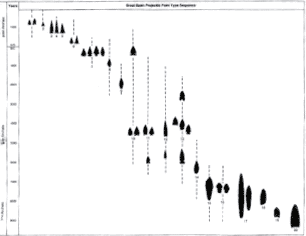
Click on the image for a larger version
Southeastern Idaho Native American Prehistory and History
by E.S. Lohse
Taken from Manual for Archaeological Analysis: Field and Laboratory Analysis Procedures. Department of Anthropology Miscellaneous Paper No. 92-1 (revised). Idaho Museum of Natural History, Pocatello, Idaho 1993.
 |
| Figure 2. Schematic of projectile point types.
Jennings 1986:Fig.1. Click on the image for a larger version |
Early Big Game Hunting Period, ca. 14,000-7,800 B.P.
Cultural adaptations during this period are marked by a focus on hunting large game animals that became extinct during the terminal phase of Late
Pleistocene or in the early Holocene. Species taken included Mammuthus, B. Antiquus, Camelops, Equus, Ovis, Cervus, and Odocoileus. It is assumed that these peoples' diet also included plants and small game. Butler (1986:128) subdivides this period into three divisions based on the presence of distinctive projectile point types: Clovis, Folsom, Plano.
Clovis Subperiod, ca. 12,000-11,000 B.P.
Evidence of this period in the Upper Snake and Salmon River country is largely confined to surface sites lacking good stratified deposits. Some stratified sites like Jaguar Cave in southcentral Idaho have deposits radiocarbon dated to this period but lack diagnostic artifacts (Sadek-Kooros 1966). In general, surface finds have been without any associated patterning in cultural remains. Butler (1963) reported a unique Clovis find at the Simon Site northwest of Wilson Butte Cave. A number of Clovis points were found with 26-30 bifaces in this cache. Butler (1986:128) reports that Clovis materials were found during construction of fish ponds on the Snake River below Twin Falls.
Folsom Subperiod, ca. 11,000-10,600 B.P.
This period is found in one excavated stratified site and abundant widespread surface finds. Owl Cave (the Wasden Site) is a deeply stratified lava tube on the Snake River Plain (Butler 1978; Miller 1982). Radiocarbon dates on bone from a Folsom component ranged from about 12,850-10,920 B.P. Parts of four Folsom points were found in association with elephant, bison and camel remains. Isolated surface finds of Folsom points are common in this region.
Plano Subperiod, ca. 10,600-7,800 B.P.
This period is the most abundantly represented in this region, and is found in excavated contexts as well as surface finds. There is a fairly wide diversity of generalized lanceolate projectile point forms. Prehistoric economy seems to have been geared toward hunting bison at lower elevations, and mountain sheep in higher zones (Swanson 1972: Table 18). Remarkable Late Plano period kills of B. antiquus ca. 8000 B.P. were preserved at Owl Cave. These include the skeletons of more than 70 bulls, cows, and calves of different ages (Butler, Gildersleeve and Sommers 1971). It seems that two separate kills were involved: one before calving season and one just after. Butler (1978) reports that a single bison nasal bone flesher and about 30 projectile points comprise the recovered tool kit. Two of the points were reworked bases of Birch Creek series lanceolate points, indicative of the earliest occupations at Veratic Rockshelter in the Birch Creek Valley (Butler 1978; Swanson 1972)